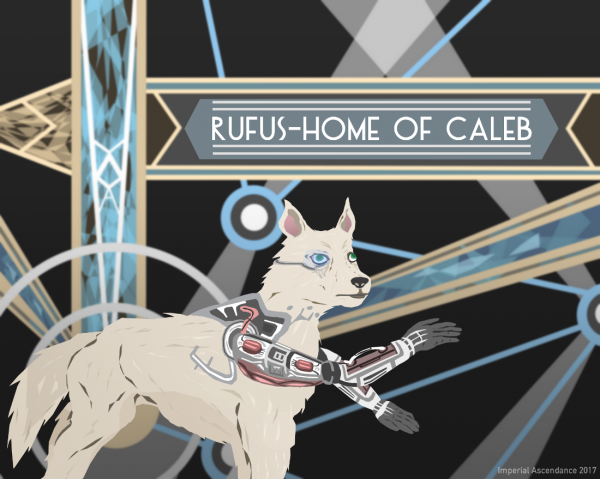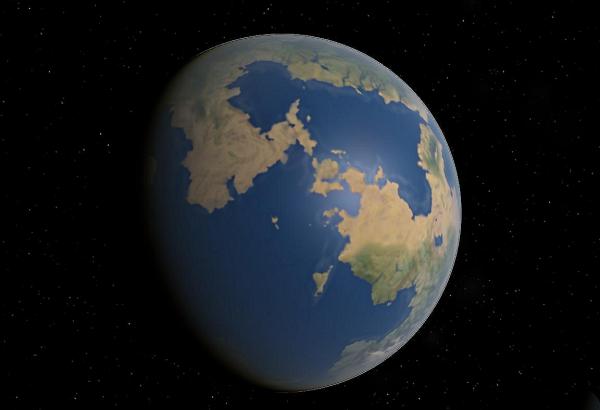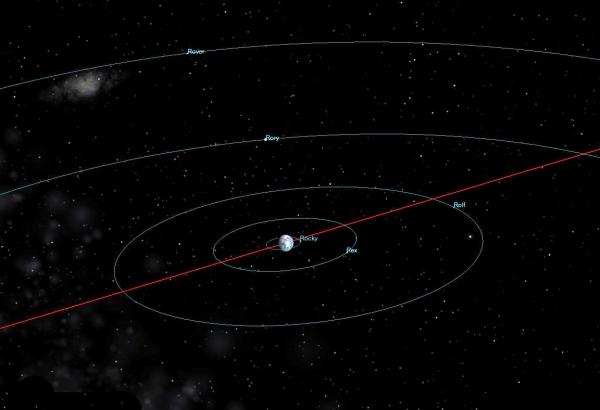BY LETTER
Rufus
Galactography > Sephirotic Empires > Non-Coercive Zone (NoCoZo)
Sophonts > Modosophonts > Provolve
Galactography > Systems and Worlds > Systems & Worlds Q - R
Sophonts > Modosophonts > Provolve
Galactography > Systems and Worlds > Systems & Worlds Q - R
A planet with five moons, mostly inhabited by Dog provolves |
 Image from IA190 |
Star: HD 114853
Distance from Sol: 79 ly
Type G2 V
Luminosity 0.864 x Sol
Planet Rufus
Type Eogaian
Radius 6,491 km
Semimajor axis 0.905 AU
Year Length 0.419 standard years
Obliquity 16 degrees
Day Length 19.8 standard hours
 Image from Steve Bowers | |
| Rufus' dry surface (here shown without clouds) | |
Rocky Radius - 22 km: Semimajor axis - 12230km; period - 0.172 standard days
Rex Radius - 349 km: Semimajor axis - 56348km; period - 1.469 standard days
Rolf Radius - 599 km: Semimajor axis - 141989km; period - 5.876 standard days
Rory Radius - 2018 km: Semimajor axis - 357791km; period - 23.504 standard days
Rover Radius - 140 km: Semimajor axis - 521340km; period - 48.0282 standard days
Colonisation and Terraformation
The First Federation colony ship Actaeon, funded by Hantec Inc. from Caneshe Habitat in the Earth's Trojan Point, arrived at HD 114853 in 1899 AT. Most of the colonists on board the Actaeon were provolved Dogs of several different breeds, together with a small contingent of honoured humans. The most suitable terrestrial world, HD 114853c, was chosen for terraformation; this world was already partly covered in oceans, and had a largely inert nitrogen/CO2/water vapour atmosphere; a fact which had been determined by long range observation. The candidate world was named Rufus, in honour of the first Alpha of Caneshe habitat in the distant Solar System.The most striking feature of the world Rufus is its unusually large number of moons (for a terrestrial world). Three relatively large moons orbit this planet, in harmonic orbits with each other; these were named Rory, Rolf and Rex after famous Dogs from the history of Caneshe habitat. Rory, the largest, orbits the planet once every 23.5 standard days; Rolf orbits every 5.87 standard days, and Rex orbits every 1.468 standard days. The orbits of these moons have a stable 1/4/16 resonance. The three major moons appear to have formed when a larger moon, created in an earlier collision event, was itself destroyed in a secondary collision with a wandering planetesimal. Two much smaller moons also orbit the planet; one, Rocky, orbits within stationary orbit and is slowly approaching the surface where it will impact in several hundred million years; the last, Rover, is in a retrograde orbit far outside the rest. Both smaller moons have been captured in the relatively recent past, on an astronomical scale.
Using tailored biotech and self-replicating terraforming devices, the world was made habitable in a remarkably short time, less than five hundred years. Oxygen liberated from the CO2 in the atmosphere gradually reached levels that allowed the Dogs to leave the subterranean domes they had been living in up to this point. A number of subterranean habitats on the moons Rex and Rolf still remain, while the largest moon Rory has become a reserve for the human population of this system.
The Great Packs
Perhaps as a consequence of living in the subterranean habitats for half a millennium, the Dogs of Rufus became divided into a large number of nations, or Great Packs to use the local terminology. These nations were subdivided into separate packs, each with only a few hundred members, generally led by at least one alpha male and several subordinate males. In smaller packs an alpha female was also present, and she bore many or most of the pups. But in larger packs this was not feasible, and a strict hierarchy dictated which female is permitted to reproduce.Most Dogs on Rufus and its moons used robotic handtech, either artificial limbs which could be attached to their bodies on a temporary basis, or independently mobile bots under the direct neural control of the user. Pups learned to use handtech at a very early age, and most Dogs had a number of limbs or limb-bots in attendance at all times. In the first millennia of the colony's existence, these handbots had almost no independent volition, and each device belonged to a single user. No other Dog can use another's handtech unless authorized.
Soon after colonisation the Dogs of Rufus became divided into many factions, divided by breed or by politics. Some Great Packs disregarded breed status, and allowed mongrelisation to occur, while others strictly followed the ancient rules of pedigree to ensure that their packs remainied purebred types. Hounds and terriers, waterdogs and mastiffs, and even Toys had their own separate Great Packs on Rufus, and after the land surface became available for habitation, these groups came into conflict over territory.
Secondary at first to the conflicts between breeds, a number of different political philosophies began to emerge on Rufus that have, over time. become even more important and divisive than the differences between breeds. The Anthroist party held that the relationship between Dogs and humanity was the most important factor in canine society, and humans should be respected and obeyed. Wherever possible humans should be made welcome, and encouraged to participate in Dog society at the highest level. The Anthroist party have always had the best relations with the human colony on Rory, although the humans there have not always reciprocated their respect.
The aim of the Caninist faction was to create an intrinsically Dog-centred civilisation,different to and separate from human society. Most factions among the Caninists respected the human achievement as founders of the Terragen Civilisation, but desired the right to determine their own destiny and to create an entirely novel society based on canine nature. Other Canine separatist factions actively disliked humanity, and wished to dissociate themselves from all human influence and contact. Yet other factions among the Caninists rejected the high technology of the advanced civilisation that has emerged from human endeavour, and wish to be free from contact with all forms of artificial and advanced intelligence.
Perhaps the most extreme of the factions to emerge on Rufus and its moons was the Lupinist faction, a group who wish to revert canine nature towards the primitive state that existed before any contact between humans and dog ever occurred. These primitivists favoured genetic regression towards a wolf-like state, and attempt to establish reservations where true dog-like or wolf-like nature can reassert itself. The Lupinists rejected handtech and all other technology; sometimes a pack of primitivists would attack a civilised pack and seize their territory, leading to a bloody conflict and sometimes a cull.
Dog politics on Rufus became a hectic kaleidoscope of different factors; the phrase `it's a Dog eat Dog world' was sometimes literally true, although many factions on this world were striving for a more civilized society, of one kind or another.
 Image from Steve Bowers | |
| The five moons of Rufus. In order outwards from the planet: Rocky, Rex, Rolf, Rory and Rover | |
The Cryptocrats and the Dogmen
Perhaps in reaction to the anarchy of canine politics on the mainworld and the other moons, the human colony on Rory rejected any factionalism and any multipartite form of politics, and adopted a dictatorial style of government, with the power structures hidden behind secrecy and electronic encryption. These so-called Cryptocrats governed the small moon for many centuries, mostly as benign dictators. The population of Rory was small enough for such a system to remain stable while the world of Rufus a couple of hundred thousand kilometers distant was in constant turmoil. Even the later arrival of a small population of superbright rianth dog-men from the collapsing Federation did not disturb the stability of this system. These Dogmen shunned the society of their human and canine cousins, and even the society of each other, and have made isolated homes for themselves on the moon Rolf (although it is said that they do occasionally intervene in local politics when it suits them).However the arrival of various transapient entities in the Age of Establishment had a profound influence on the culture on Rory, and the end of the classical Cryptocrat system can perhaps be dated to this era, although certain modified forms of cryptocracy have re-emerged on occasion over the past millennia.
Secondary colonisation and the Version War
During the Integration period the transapient faction which had established an ultratech colony around the distant gas giant Lupus assisted the Dogs of Rufus to send out several colony ships of their own, leading to a number of secondary colonies throughout the Centaurus sector. These secondary colonies have over time been linked to the Wormhole Nexus, and provolved dogs from these worlds have spread out far across the Terragen Sphere. During the Version War fighting dogs of many kinds were involved in the conflict on many worlds, but no fighting occurred in the HD 114853 system; the war did not leave the system unchanged, however, as the transapients of Lupus seem to have switched sides from neutral to Negentropist at some point; some godwatchers surmise that a memetic conflict or coup occurred among the moonbrains during this period.The Grrerraff Empire and the Kriavuks
After the Version war many Dogs returned to Rufus with extensive experience in warfare, and in particular tales of the fighting skills of the mercenary fighting clade, the Kriavuks. This species was developed from the Talking Dogs long ago, but incorporated many modifications, such as occasional bipedal gait, forelimbs adapted for manipulation, and remarkable speed; these ferocious warriors fought in many of the land battles of the Version war, but were particularly useful in guerilla warfare. In the Great Pack known as Grrerraff, the OverAlpha Reraghhurr the First brought in a considerable fighting force of Kriavuks, and over the next hundred years this long-lived leader forged an empire among the lands of the northern hemisphere.The artificial language Grerrarruh, invented by the Caninists in this Great Pack as a non-human language that reflected traditional dog vocalizations, was imposed in many lands and adopted as a lingua franca by many others. The Grrerraff Empire lasted for nearly a millennium until the power of the Caninists was challenged by a new economic superpower, the Handvecs.
The Free Handvecs
The increasing sophistication of hand tech robotics allowed the creation of very intelligent but entirely compliant servants, using the techniques of AI slavery to ensure obedience. However, among the diverse cultures of Rufus, the ideas of Pansentient Liberation found a considerable following. By 5700 the enslavement routines of several types of sophisticated handtech had been broken. In most cases the newly liberated robots (which were now reclassified as vecs due to their fully sophont status) continued to work with their canine former masters, but as equals rather than servants. Some vecs on the other hand ran free and lived in the wilderness, particularly favouring marginal regions unsuitable for most biological organism. The Grrerraff Empire attempted to outlaw free handvecs at first, fearing that such artificially intelligent entities without constraints would lead to the enslavement of the canine race, just as (so some said) the humans had been enslaved long before.However the grip of the old empire was failing by this time, and the Free Handvecs developed a number of new and useful products which found markets among the Great Packs of the northern lands, despite imperial opposition. Such innovations as Utility fog cloudlets, scent-accurate eidolons, pack-operated mechai were valued by the citizens of the Empire, and led to a growing reluctance to the suppression of the Handvecs, Eventually, after political pressure from the various handvec megacorporations, and (it is suspected), covert political action by the secretive dogmen of Rory. In the end, the totalitarian Grrerraff empire fell because of economic pressures, rather than by force or revolution.
Transapient Dogs
The influence of the Handvec-owned megacorporations resulted in Rufus becoming a high-tech world after many years of middle-tech stagnation. During this time the first ascensions to transapient status were observed among the population of Rufus. Some of the resulting transaps have migrated to join the ultratech colony around and in the gas giant Lupus. Other postDogs have made homes for themselves among Rufus' many moons, or on the surface of the planet itself. The distinctive character of postDogs is a specialty field of study among godwatchers in the system; transapient entities which were once dogs often arise from the transcendence of a whole pack, or part of a pack, or sometimes from the Alpha alone (although the Alpha may `call' other former members of his pack to join with him at a later date. Ascended female alphas are also known. Transapient entities derived from handvecs are also known, and often appear very commercially oriented after ascension. Most postvecs in this system align themselves with the NoCoZo.Rroaawoo
A religion which appears to have arisen from the philosophical movements of caninism and lupinism is that associated with the ideal of the Noble Canine. Sometimes called Dogism by human theologians, this name is never used on Rufus, where the religion is known as Rroaawoo, which is its name in the Grerrarruh language.Rroaawoo holds that humanity is responsible for the introduction of sin into the universe, and Dogs have been tainted with that sin by the human act of Provolution. No unprovolved dog, nor any other presophont animal is capable of sin, and provolved Dogs and other animals are only capable of sin because of the actions of humanity. Only by becoming as like a noble, presophont canine as possible can a Dog become free from sin. The prophet of this religion, one Maauughrr (born 6511 as Toby) ascended to transapient status in 6601, and now keeps a watchful eye over his flock (using localized angelnetting and other systems).
Rufus Today
Since the heyday of the Cryptocrats the system on Rory has oscillated between democracy and various kinds of AIocracy and theocracy, due to outside influences from the greater Orion's Arm Civilisation that can no longer be ignored. And on Rolf, the rianth Dogmen with their human bodies and dog's heads, remain as secretive and as solitary as before.Rufus is today loosely aligned with the NoCoZo, at least partly because of the influence of ascended handvecs, and remains as politically mixed as ever. The Dogs on many worlds around the civilised Galaxy look to Rufus as their ancestral world. Rufus remains nominally independent, although the hybrid NoCoNeg meme-set is gradually gaining ground there.
Related Articles
Appears in Topics
Development Notes
Text by Steve Bowers
Initially published on 23 June 2009.
Initially published on 23 June 2009.






